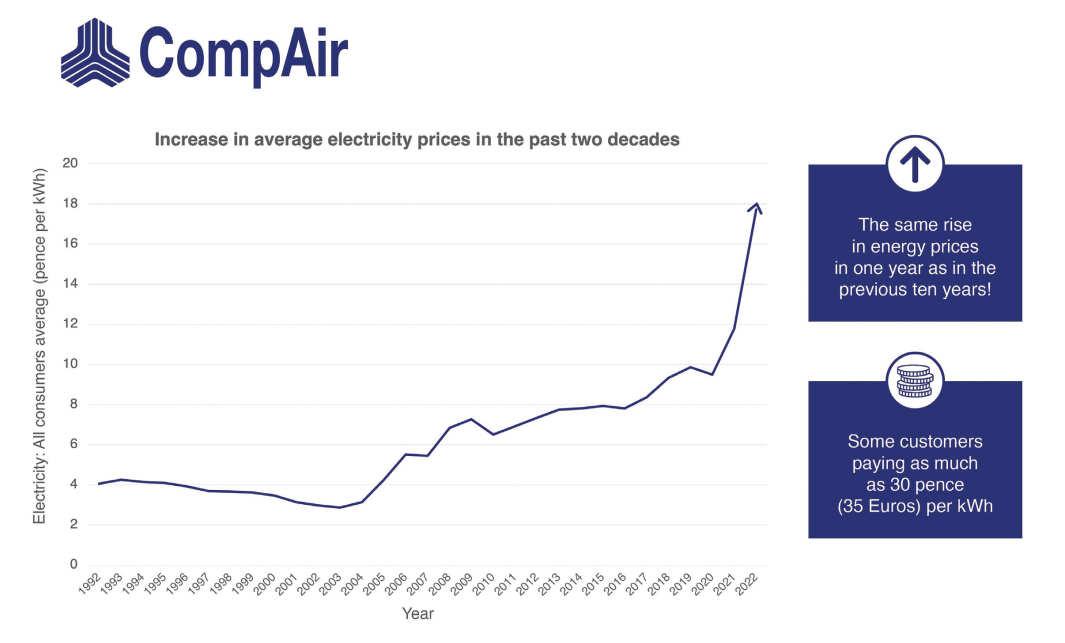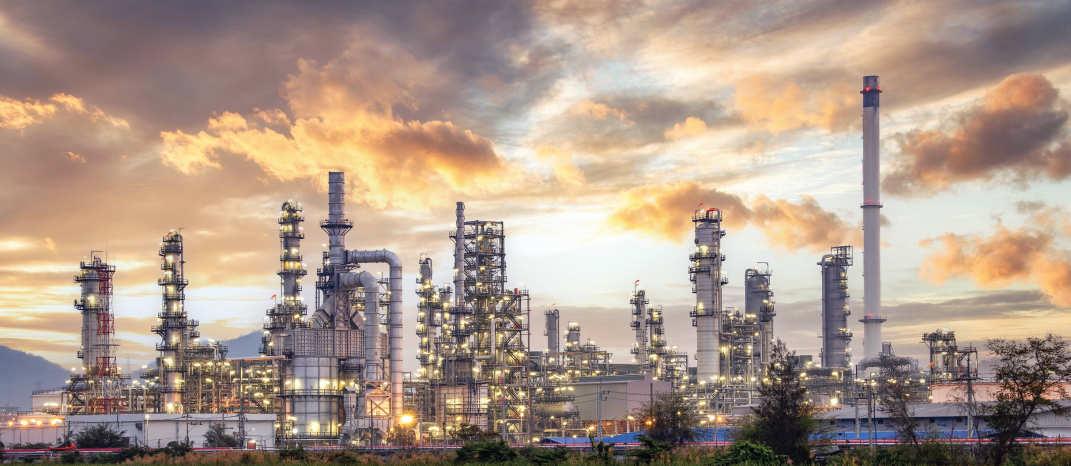
4 minute read
The drive for energy efficiency in compressors
OPERATORS IN THE industrial and process industries are experiencing substantial increases in electricity prices, and many customers are looking for new ways to lower the impact of their compressed air energy consumption and mitigate for further price increases.
Leading compressor manufacturer CompAir estimates that with the global rise in electricity prices, the energy costs of compressed air have increased to as much as 91% of the total cost of ownership, with the result that customers now need to re-evaluate the way they assess their compressed air energy costs.
“Total running costs over the last 10 years for a 160-kW compressor have more than doubled. Put simply, for every 100,000 Euros spent on compressed air previously, around
82,000 Euros of this was the energy costs. Now, this figure has risen to 91,000 Euros –with energy costs doubling in the last two years alone,” says Graham Read, product manager Industrial Compressors Europe at CompAir.

“Many customers are talking to us about how they can future-proof their compressed air installation to help mitigate any further price increases.”
High-performing energy-efficient compressors can help bring down energy costs, while reducing emissions. CompAir’s new L160e, 200e and 250e kW FourCore compressor range, for example, offers all the capabilities of an oil-lubricated two-stage compressor with the footprint of a singlestage unit. The compact, two-stage airend uses four gears rather than three, to deliver flexible rotor speed adjustment at both low and high pressure, as well as the best possible performance at different discharge pressures and shaft speeds. When compared with previous single-stage compressors in the size range, the new models are up to 8% more efficient, saving up to 12,000 Euros a year. The range also offers integrated heat recovery, enabling the heat generated from the compressor to be re-purposed to heat water, for space heating, or for application processes in other areas of the installation.
“While not every site will have the available capital expenditure to invest in a new energyefficient compressor, significant savings can still be made by adopting a ‘measure, manage and improve’ approach,” says Read. He adds, “By understanding how the cost of ownership balance has shifted, and adopting a systembased approach, customers can achieve rapid payback on any investment made.”
Compair offers an air assessment service which looks at all aspects of a compressed air system’s performance, including power and flow data, pressure measurements, leak detection and heat recovery. Using data logging, precise measurements are taken to give a comprehensive overview of energy performance. Suggestions can then be made on potential equipment upgrade or investment through to simple equipment optimisation and low-cost elements, such as fixing leaks, reducing pressure and switching off compressors when not in use.
Compressor manufacturer FS-Elliott estimates that in the case of a 500HP compressor system, a 3% efficiency improvement could equate to an 11kW power reduction, saving almost US$12,000 yearly in net profits, and reducing carbon dioxide emissions by up to 69,080 kg.
As the company points out, “Energy saving is more than saving money for factory operations, it is also about protecting, sustaining, and contributing to a better environment for us and our society.
Environmental, Social, and Governance (ESG) initiatives are more critical in today’s daily production activities than before.”
According to FS-Elliott, studies have concluded that industrial plants waste around 30% of compressed air. Many different factors can contribute to this. Clogged air filters can cause pressure drops or higher pressures, which turn into costly wasted energy. Random leaks in air delivery can generate false artificial demand and create more wasted energy. offering digital solutions for remote monitoring, providing full visibility of systems in real time and thus facilitating performance optimisation and energy savings. In August 2022, FS-Elliott announced the launch of FS-Connect, a 4G web-based connection designed to provide visibility of the operation status, performance compressor activity, and remote troubleshooting support. FS-Connect provides a live report of compressor status, including operational and maintenance notifications, monthly summary reports, and monitoring pressure/vibration/temperature. It also provides maintenance tracking and energy-saving recommendations.

FS Elliott suggests that airend rerates are the most economical and efficient way to offer new operating conditions, while an airend derate is another energy-saving option when an air compressor is too large for a specific application.
Condensate drains which remove moisture (condensate) from intercoolers and aftercoolers prevent over-draining and underdraining, preserving your system pressure and stopping wasted compressed air.
The right control panel for your air compressor will makes it easy to monitor the compressor, and adjust settings when needed, FS-Elliott adds.
For example, FS-Elliott’s Regulus line of control panels, including the R1000, R2000, and R400, offer precise air system pressure control, maximised turndown capability, advanced adaptive control permits, protected operations for surges, built-in control modes that adapt to changing conditions, and multiple compressor energy management.
The R2000 offers the Energy Advisor and Maintenance Notification System as standard features. The Energy Advisor allows the user to monitor the efficiency level of their compressor operation and provides recommendations for improved efficiency.
Compressor manufacturers are increasingly
"We believe that this new remote monitoring solution can be a powerful addition to any of FS-Elliott’s Regulus Control Panels, as it provides our users the ability to not only monitor the operational status of their compressed air system but will also help improve efficiency and compressor uptime through remote notifications and reporting. As an addition to FS-Connect, we are also excited that the FS-Connected Services option will provide a new level of service offerings to FS-Connect users, helping them troubleshoot on-site issues in a productive and timely manner,” said Justin Johnson, product manager, Controls at FS-Elliott.
Similarly, Compair’s i-Conn digital cloud platform supplies compressed air users with comprehensive machine data in real time, which is required for precise production planning and to protect their investment. It enables service teams to monitor the compressed air system remotely and predict when maintenance or service is required, to avoid the likelihood of any equipment downtime. n
For further information see: https://www.compair.com/en-gb/sustainablecompressed-air https://www.fs-elliott.com/Blog-Item-TheImportance-of-Energy-Efficiency
Revamp optimises energy efficiency and reduces emissions
IN A CASE study on its website, Burckhardt Compression describes how a customer, a global chemicals company, experienced optimised energy efficiency and fewer emissions after a compressor revamp. The company was operating two vertical process gas compressors its petrochemical plant, and was experiencing high leakages, reduced gas flow, temperature issues and a very short lifetime of wear parts, leading to frequent compressor shutdowns and wasteful energy consumption.
Burckhardt Compression conducted a detailed system integrity analysis, which showed that the cylinder liner was damaged due to inappropriate piston ring material. Burckhardt Compression’s solution involved the upgrade of piston/packing rings to Persisto 850, a material specially developed for sealing applications in dry-running reciprocating compressors. The piston rod was repaired and packing and other components refurbished at Burckhardt Compression’s local service centre.
“Burckhardt Compression’s solution with the right selection of material helped us to increase compressor availability significantly,” said the customer. “Thanks to their analysis, we now better understand the component failure modes. Our second compressor, which was plagued by the same issues, is now being revamped by Burckhardt Compression, too.” https://www.burckhardtcompression.com/wpcontent/uploads/2022/11/315_Success_Story_ Revamp_Energy_Efficiency.pdf





